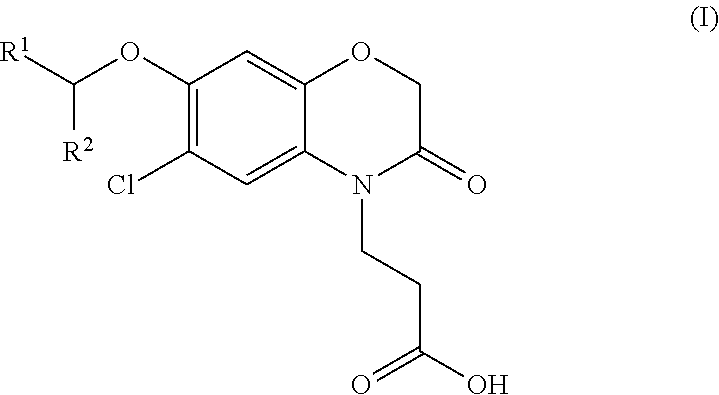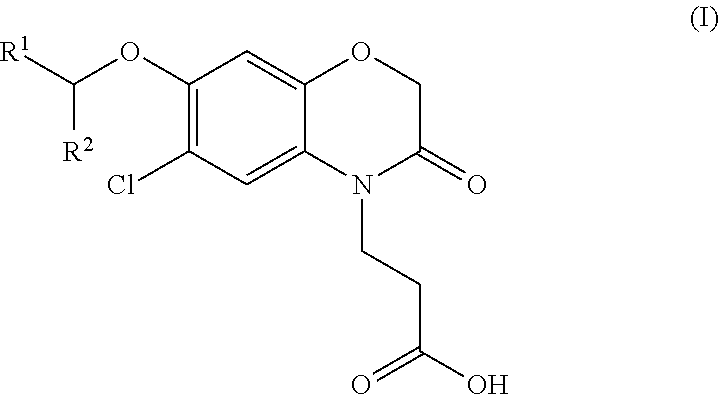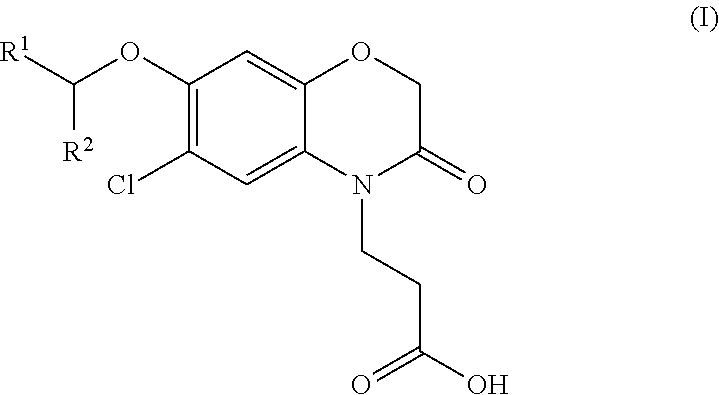3-(6-chloro-3-oxo-3,4-dihydro-(2H)-1,4-benzoxazin-4-yl) propanoic acid derivatives and their use as kmo inhibitors
a technology of dihydro-(2h)-1,4-benzoxazine and derivatives, which is applied in the field of 6chlorobenzoxazine compounds, can solve the problems of rapid progression to multiple organ dysfunction (mod), and no effective treatment availabl
- Summary
- Abstract
- Description
- Claims
- Application Information
AI Technical Summary
Benefits of technology
Problems solved by technology
Method used
Image
Examples
example 1
Chloro-7-(1-(5-chloropyridin-2-yl)propoxy)-3-oxo-2H-benzo[b][1,4]oxazin-4(3H)-yl)propanoic acid
[0219]
[0220](R)-Methyl 3-(6-chloro-7-(1-(5-chloropyridin-2-yl)propoxy)-3-oxo-2H-benzo[b][1,4]oxazin-4(3H)-yl)propanoate (9.0 g, 20.5 mmol), THF (50 mL) and lithium hydroxide (0.5 N in water, 50 mL) were mixed and the reaction was stirred at room temperature for 2 h. Water (150 mL) was added and the mixture extracted with ethyl acetate (50 mL×3). The separated aqueous phase was adjusted to pH 6-7 with hydrochloric acid (0.5 N). The mixture was filtered and the solid was collected and dried over air to give (R)-3-(6-chloro-7-(1-(5-chloropyridin-2-yl)propoxy)-3-oxo-2H-benzo[b][1,4]oxazin-4(3H)-yl)propanoic acid as a white solid (6.5 g).
[0221]LCMS: Rt 1.59 min, MH+ 425 / 427;
[0222]1H NMR (300 MHz, d6-DMSO) δ 12.37 (s, 1H), 8.63 (d, J=2.4 Hz, 1H), 7.95 (dd, J=8.4, 2.5 Hz, 1H), 7.46 (d, J=8.4 Hz, 1H), 7.38 (s, 1H), 6.66 (s, 2H), 5.36 (t, J=6.2 Hz, 1H), 4.04 (t, J=7.4 Hz, 2H), 2.10-1.88 (m, 3H), 0....
example 1 (
Alternative Preparation): (R)-3-(6-Chloro-7-(1-(5-chloropyridin-2-yl)propoxy)-3-oxo-2H-benzo[b][1,4]oxazin-4(3H)-yl)propanoic acid
[0223]
[0224]To (R)-methyl 3-(6-chloro-7-(1-(5-chloropyridin-2-yl)propoxy)-3-oxo-2H-benzo[b][1,4]oxazin-4(3H)-yl)propanoate (0.8 g, 2.05 mmol) in THF (50 mL) was added lithium hydroxide (1N, 8.2 mL, 8.2 mmol) and the mixture stirred at room temperature for 2 h. The solvent was removed, hydrochloric acid (0.5 N) added to adjust the mixture to pH 5 and the mixture extracted with ethyl acetate (20 mL×5). The combined organic extracts were dried over sodium sulphate, the solvent removed and the residue purified with prep-HPLC (column: Diasogel C18 250×50 mm, 10 um; eluent: ACN-H2O=50-80, 0.1% formic acid) to give (R)-3-(6-chloro-7-(1-(5-chloropyridin-2-yl)propoxy)-3-oxo-2H-benzo[b][1,4]oxazin-4(3H)-yl)propanoic acid as a white solid (590 mg).
[0225]LCMS: Rt 1.60 min, MH+ 425 / 427;
[0226]1H NMR (300 MHz, CD3OD) δ 8.54 (d, J=2.4 Hz, 1H), 7.83 (dd, J=8.4, 2.5 Hz, 1H...
PUM
| Property | Measurement | Unit |
|---|---|---|
| enantiomeric excess | aaaaa | aaaaa |
| enantiomeric excess | aaaaa | aaaaa |
| enantiomeric excess | aaaaa | aaaaa |
Abstract
Description
Claims
Application Information
 Login to View More
Login to View More - R&D
- Intellectual Property
- Life Sciences
- Materials
- Tech Scout
- Unparalleled Data Quality
- Higher Quality Content
- 60% Fewer Hallucinations
Browse by: Latest US Patents, China's latest patents, Technical Efficacy Thesaurus, Application Domain, Technology Topic, Popular Technical Reports.
© 2025 PatSnap. All rights reserved.Legal|Privacy policy|Modern Slavery Act Transparency Statement|Sitemap|About US| Contact US: help@patsnap.com



